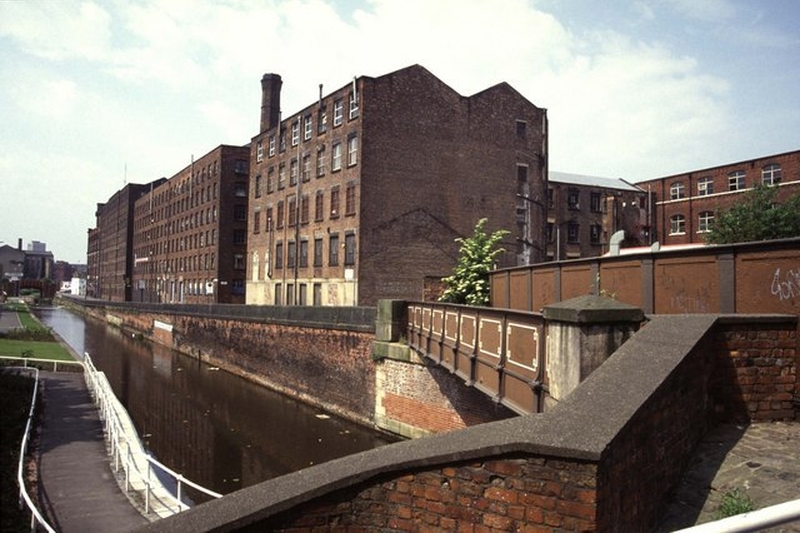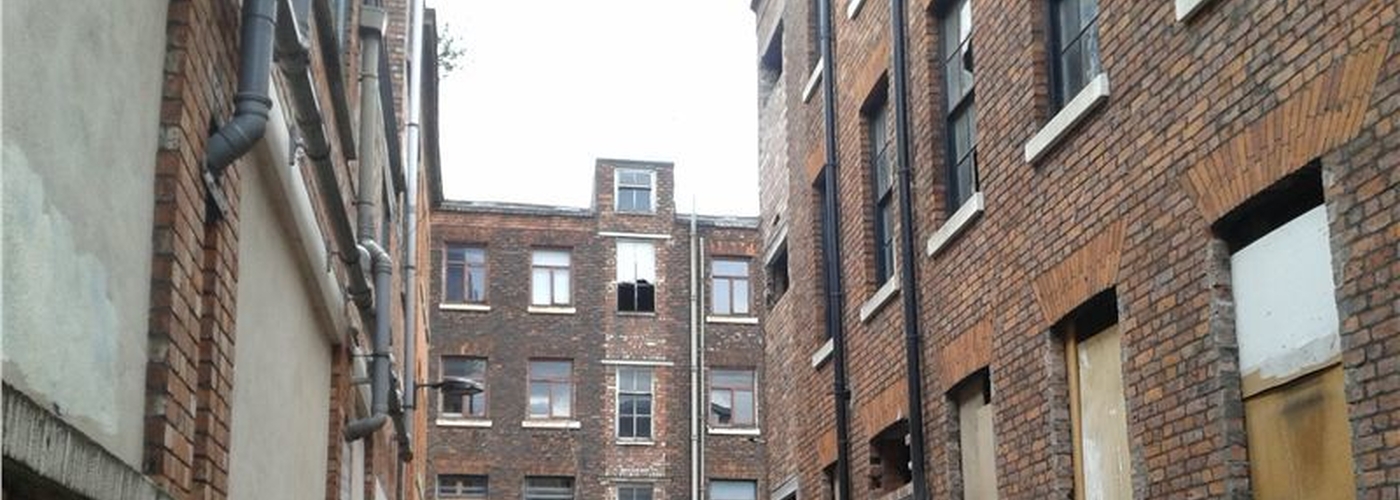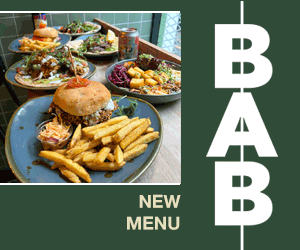Factories, warehouses, street art and a few things you probably didn't know...
Updated 2023.
The Northern Quarter has seen radical changes in the last forty years. It was for many years an upscale shopping area, then with the opening of the vast Manchester Arndale in the late 1970s it fell onto hard times. From the 1980s onwards, often painfully slowly, it has emerged as a creative quarter for the city, rammed solid with public art and a centre for the creative industries. Some now worry that the growth of bar culture has changed the atmosphere in the Northern Quarter but others think the complainers are the first generation of the new Northern Quarter who have just got older.
It’s a fascinating area to walk over and there will never be a moment when you run out of food and drink options. Some artworks are mentioned in the main tour below but there’s also a closer examination during part two of the tour. As a handy hint though, one set of artworks is useful for this tour. Blue tiles with white writing are orientated east to west, while white tiles with blue writing are found on north to south streets. These were designed by Majolica Works and reflect the weave of the Northern Quarter, its warp and weft.
Start this walk at the junction of Lever Street and Stevenson Square close to Flok Bar. If open, the latter has an entertaining strong room in the cellar behind a mighty door, a clue to its former role as commercial premises. Many of the warehouses, offices and former banks sport similar basement features.
Stevenson Square was created sometime after 1780 when the profligate yet fascinating Sir Ashton Lever sold off 10 hectares (25 acres) of land. More about Sir Ashton later but the chief beneficiary was William Stevenson, a crafty property speculator who had an eye for a deal. Not one to be shy he decided to create an elegant district of housing for the middle classes focussed, naturally, upon a square named after himself.
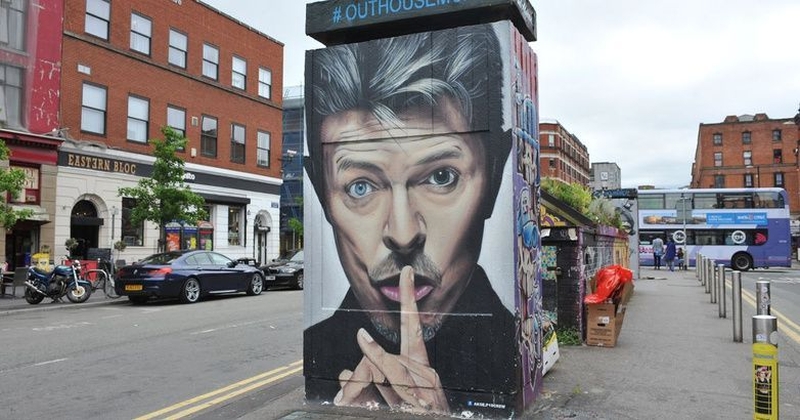
In the 1780s Stevenson Square was on the fringe of the town and close to the gardens surrounding the hospital in Piccadilly. The gardens were fronted by a promenade which allowed the well-to-do a recreation area in which to people-watch and gossip. There are traces of classic Georgian houses in many streets around, including a particularly handsome version at 8 Lever Street, south west from the square.
The many changes in the area means the square is very uneven architecturally. A church was built on the south west side of the square in 1793. It was demolished in the 1870s. The church had never stood a chance. Manchester’s meteoric growth as business and industry boomed meant the mills, workshops and factories appeared. Meanwhile houses were first split into tenements for the poor and then mostly demolished to provide space for warehouses.
The most spectacular in Stevenson Square was that of a firm called I.J & G. Cooper from 1906 by John Bowdon, on the other side of the square from Flok. This is all red brick, terracotta and sandstone in what is known as the eclectic style (meaning anything goes). It hosts Manchester’s second oldest retailer, Fred Aldous, an arts and crafts shop which first opened in 1886. The shop makes for an entertaining visit, but make sure you get down to the basement.
There is lots of street art in Stevenson Square. The edginess of much of the work chimes with the previous nature of the square as Manchester’s Speakers’ Corner. People would shout politics, poetry and religion. One man was so good at proselytising he was hired at different times by Methodists, the Church of England and the Roman Catholics. Flexibility is after all a virtue. In 1892, 60,000 people on 1 May began a ‘Labour Day’ walk to Alexandra Park from the square.
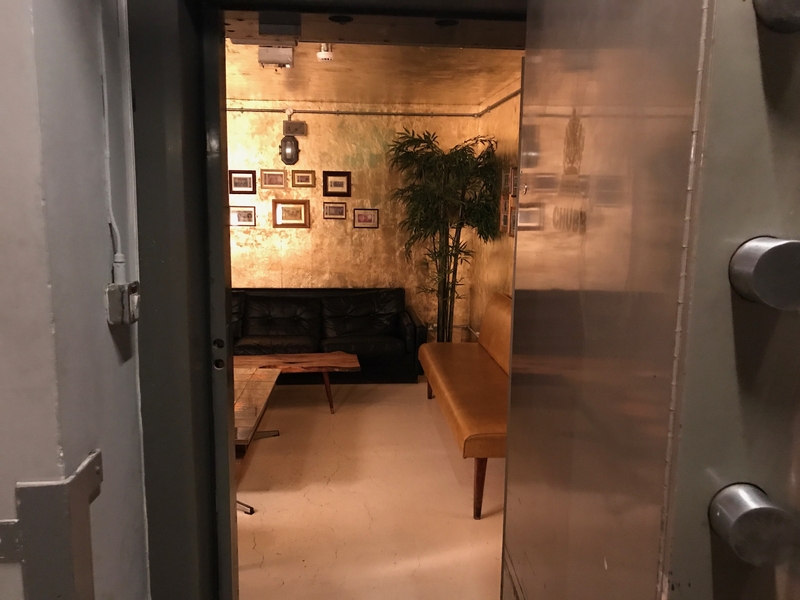
Suffragette, Emmeline Pankhurst spoke here on several occasions. When her daughter Christabel, and fellow campaigner Annie Kenny, were imprisoned for disturbing the Liberal Party meeting at the Free Trade Hall in October 1905, Pankhurst attended a meeting at Stevenson Square. This was on the occasion of Kenny’s release. One man suggested votes for women would cause discord and, to laughter, while tripping over his words, said, “In the home the man is the masterpiece.” Pankhurst retorted, to cheers, “We do not believe in masterpieces, we believe in equals.”
Other important meetings here included pro-Spanish Republic speeches at the time of the Spanish Civil War which encouraged many Manchester men to join the International Brigade.
With your back to Flok bar, turn right and leave Stevenson Square via Hilton Street. At the junction with Oldham Street, and a little to the left down Oldham Street, in the pavement, is Soundbites by Tim Rushton, featuring metal plates referring to Manchester popular music such as Oasis, the Buzzcocks, Factory Music and so on.
Cross over Oldham Street and continue along Hilton Street. Continue until the street opens out a little next to a drab, beige 1970s multi-storey car park. The most entertaining artwork here is a large broom and dustpan mounted on stone. This is from George Wylie and is called New Broom. It serves as a hint to the council to maintain street-cleaning, a frequently ignored quality, and a celebration of ‘the ordinary working people, who give the area its character and vitality’. The head of street-cleaning was present at the unveiling. His surname was aptly, Broomhead.
The multi-storey car park squats on the site of St Paul’s Church from 1765. It was described as having ‘a very unprepossessing appearance’ although perhaps it’s safe to say it was less unprepossessing than the appearance of the car park. Still, the latter has come in useful for scenes in films and TV dramas set in the 1970s such as the BBC’s Life on Mars.
At this point Hilton Street becomes Thomas Street. Look down John Street to see exotic sculpted birds on brackets by Guy Holder, a reference to the many pet shops that used to be in this area. A few metres down after the junction with John Street, there’s a brick feature protruding from the wall on the left. This was the entrance to a WWII bomb shelter for the area. In the cellar of the building here there are still traces of stencilled 1939 signs such as the lovely one labelled ‘urine buckets’. One part of the wall in the underground space is only one brick course thick so should the main entrance be wrecked during a raid people might knock through here and make their escape.

The last building on the left, Binks Buildings, at the junction with High Street is surmounted by an entertaining and large pineapple ceramic by Kate Malone. This was installed in the 1990s and is a symbol of ‘friendship and hospitality’ appropriate given the Northern Quarter’s transition into an area of leisure and recreation. The building now hosts vegan restaurant Folk and Soul.
Turn right up Oldham Street and dominating on the left side of the cobbled street is the long range of the former wholesale fish market. This building, from 1873, was designed by Speakman, Son & Hickson, but it’s the charming sculptures in the tympanum of the High Street facade that are the highlight. These are by Joseph Bonehill and show men, women and children involved in the fishing trade. Turn second right on High Street onto Copperas Street and walk to Oak Street.
It was in 1867 on Oak Street when two Fenians were arrested, an event that would lead to murder and public execution. Turn left, under the canopy of Manchester Craft and Design Centre, and into the building if it is open. This is another fish market, this time for retail, was also by Speakman’s, as with the nearby wholesale fish market, and dates from the same time. Inside, some of the old market booths survive in a handsome and airy space with a good floating display of artworks. The building closed as fish market in 1973 and opened as the Craft and Design Centre in 1982.
One of the booths bears the name Gibbons and recalls the woman who ran the stall for many years. One of her grandsons recalled: ‘Ellen Gibbons, worked at the fish market from some time in the thirties till it closed. It was a hard life, working as a woman in a man’s world (and a very little woman at that, 5ft (1,52m) in her clogs). She said she had to tell the chap opposite that he’d feel the toe of her son’s boot if he carried on with language he wouldn’t use in front of his own mother or wife, and kept trying to take her customers.’ In 1981 the Granada TV production, Brideshead Revisited, filmed Anthony Andrews, as Sebastian Flyte, crashing his car into the building.
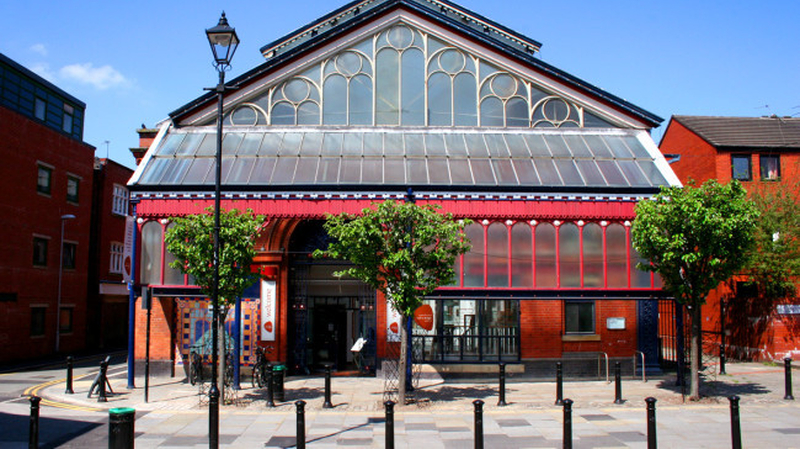
Leave the Craft and Design Centre by the opposite entrance to Oak Street and turn right on an inconsequential little walkway of William Fairbairn Way.
William Fairbairn deserves more than this, he was one of the greatest British engineers of all time. It was close to this location where, in 1817, this Scottish born gentleman set up his first workshop, later developing a huge engineering factory in Ancoats. He was a structural engineer for major building projects, a boilermaker, a shipbuilder and frequently a pioneer.
His own patent, with Eaton Hodgkinson, for a wrought-iron girder was the basis for all subsequent girders that hold up the world’s buildings. There were the numerous waterwheels, ships, bridges, iron-framed mills and forms of industrial machinery too. To add insult to injury the sign for William Fairburn Way has not been engineered correctly to fit on its host building.
Walk up William Fairburn Way and to Swan Street and turn left. The building here is Mackie Mayor, from 1858 as the Butcher’s Market. It’s named after the Mayor of Manchester at the time, Ivie Mackie.
Alderman Goadsby, at the opening (and who has a neighbouring street named after him) explained how it was only in 1845 that the city had bought the market rights from the control of Sir Oswald Mosley, the old lord of the manor. He said this was done ‘to remove from the streets a number of unsightly stalls and to get rid of the last badge of feudalism’.
This Smithfield area was deemed the only suitable place for large scale market development. The markets kept expanding until by 1897 the wholesale markets covered 1.61 hectares (4 acres) and were easily the largest in the UK. After WWII such a prominent city centre site was deemed unsuitable and the wholesale markets were pushed out to a soulless location in the suburbs. With it went lots of daft games and competitions. For instance, there were sacks of potatoes races and, in 1929, Jack Winters won £4 for running four miles with a 50 kilo (8 stone) bag.
The fact many of the traders in the markets were smaller scale rather than large is reflected in the way so many three storey buildings have survived. The Northern Quarter has a lower building profile than any other part of the city centre. It had the largest number of pubs as well to serve the traders and in a curious example of history recycling itself, it has again the largest density of city centre licensed premises given the arrival of countless bars since 2000.
Mackie Mayor has been reinvented after many years of dereliction as a very popular market hall. The building is good-looking on the outside with its sturdy Classicism and bull’s head adornments, but the magic is on the inside, with the airy interior featuring splendid and slender iron columns.
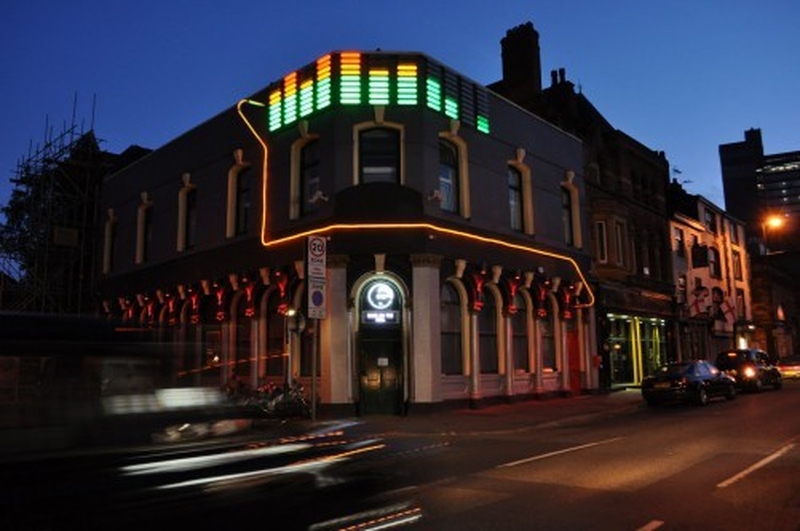
With your back to Mackie Mayor on Swan Street, turn right to the junction with Oldham Street, passing Band on the Wall. This has been a music venue for more than a century.
It started life as the George and Dragon pub. In the 1930s a landlord called Ernie Tyson, because of space limitations, placed an elevated stage high on the wall and the pub got the nickname Band on the Wall. This name was adopted formally in 1975 when music took over. Initially the emphasis was on jazz and over the years Band on the Wall has developed into a premier northern venue for jazz, blues and world music.
It is now run as charity but maintains a very progressive musical policy involving much youth work. The outside of the building sports a jolly art piece by Michael Trainor, in the form of a giant graphic equalizer which visually reflects for the passer-by the music being played inside.
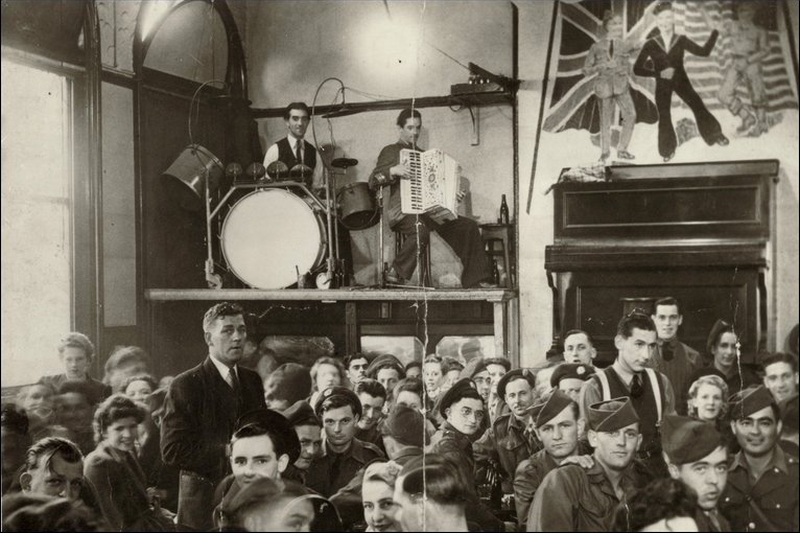
It was on Swan Street where one of the cholera hospitals was located. Here one of the darkest episodes of Manchester life took place in 1832 during an epidemic. On 31 August, John Brogan was admitted to the hospital. He was three and was sadly dead by the evening. During his burial his grandfather John Hayes became suspicious and insisted the coffin was opened. Brogan’s head was missing, replaced by a brick.
Brogan was part of the Irish community and a rumour spread that he had been murdered. A mob seized the coffin and a crowd of up to four thousand people attacked the hospital and ransacked it. Three troops of the 15th Hussars were required to contain the trouble. Some thugs stole Brogan’s remains and extorted money and goods apparently for family funeral expenses, but in reality to pocket the proceeds for themselves. The situation was only calmed by the local priest, Father Hearne, who investigated what had happened and then explained it to the population.
It turned out that a dispenser at the hospital, Robert Oldham, had removed Brogan’s head as part of a medical investigation. Hearne recovered the head, restored it to the body and gave Brogan got a decent burial.
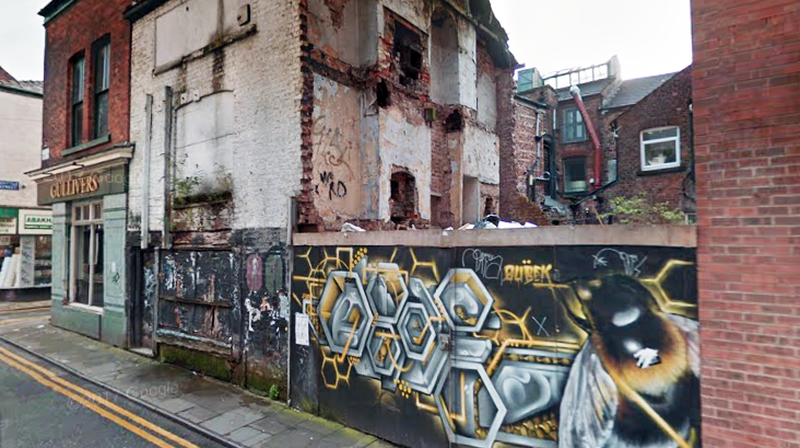
Further along Swan Street arrive at Tib Street, where Manchester's pet shops were centred for many years. There are sculptural works marking this down the street. Tib Street was named for the tiny stream which was given the grand name of River Tib. This was probably a joke as it was said that ‘one very dry season the current was stopped by a cabbage stalk’. In the end the stream became such a smelly disaster it was culverted in 1783.
In the late nineteenth century Manchester gained a substantial southern Italian population of economic and political migrants. Parts of Ancoats, which we will encounter soon, became known as Little Italy around George Leigh Street, Jersey Street and so on and remained this until the break-up of the community after WWII.
This district had its own celebrations, processions and societies. Italians found work amongst other things as crafts people providing skilled hand masonry for the building trade. One of the small streets at the top of Tib Street became known as ‘lickers’ alley’. This was down to the introduction of ice cream. Italian ice cream makers and their staff would push carts around the streets, and in the early days people would ‘lick’ the ice cream off a sheet of glass, which was then washed in a contraption on the trolley. Rumour stated that customers might contract typhoid along with some delicious ice cream. One community story states that the biscuit cone was invented by Antonio Valvona in Ancoats.
